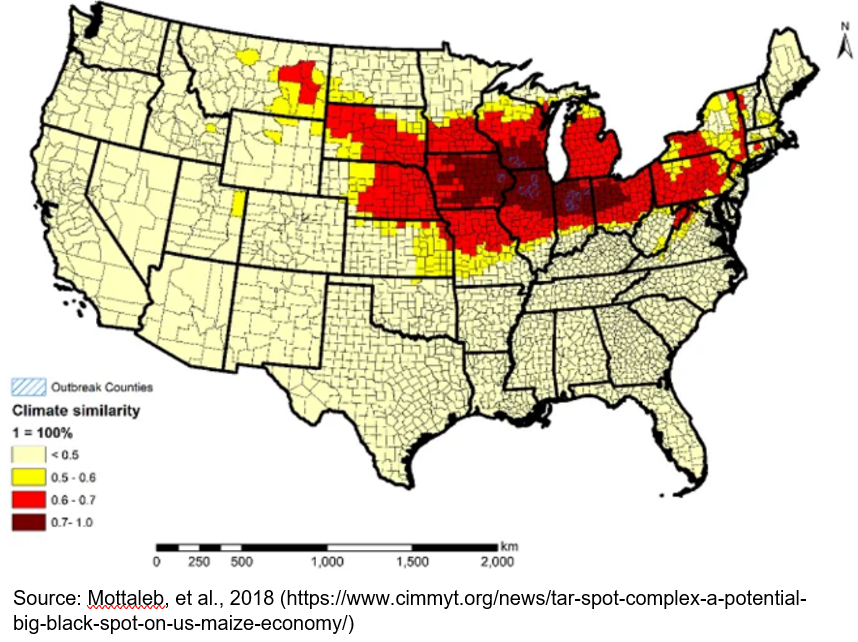Prudent Preparations for Tar Spot
Since its widespread arrival to the Midwest in 2018, tar spot disease of corn has become an increasing topic of concern for farmers. This year, farmers in several states have reported severe yield losses (e.g. of 30-50% of whole farm averages). In such cases, fields were typically continuous corn where tar spot was noted last year. Furthermore, tar spot symptoms in those fields were abundant by R1, crop nutritional stress was higher, and weather conditions promoting a second cycle of the disease occurred between R1 and R4.
Tar spot is not a new disease, just new to our part of the world. Where it is endemic, the following is known about how to optimally manage the disease.

Figure: Maize-producing counties in the USA that are vulnerable to Tar Spot Complex (TSC) of maize, developed based on climate analogue model analysis procedure matching historic climatic data of 13 counties where TSC has been detected.
- Select hybrids that show measurable tolerance or resistance as well as good yields. When selecting hybrids, yield potential, disease resistance, pest resistance, as well as the utility and marketability of engineered traits in one’s local area should be considered. Hybrids that are currently available in the US have either poor or moderate tolerance to tar spot, so select those with the greatest tolerance for any fields where tar spot risk will be high.
- In fields where tar spot was present last year, avoid replanting corn to reduce the buildup of inoculum. Nearly all fields reporting severe disease were continuous corn with higher planting densities. Because infested corn residue increases disease risk the following year, it will be prudent to rotate away from corn in fields next spring where tar spot was seen in 2021.
- Reduce crop stress to minimize disease development. Dozens of pathogens are endemic to the Midwest USA, and all present a risk to farmers’ incomes. Because health, well-fed plants develop fewer symptoms of disease, continue to improve soil health and provide balanced nutrition using the Maximum Farming System.
- Track risk development before applying extra fungicides. Field scouting and disease forecasting programs, like Tarspotter can determine if specific disease or pest risks are high or low for your area. In-season monitoring of weather-related risks can help you determine if extra pesticides sprays, or even more common preventatives, are likely to be cost-effective.
- Know which chemistries are most effective for the full range of disease risks in your fields. Because weather is variable from year to year, it is a fool’s errand to select fungicide chemistries based solely on last year’s disease problems. Currently, there are few fungicides specifically registered for tar spot control, but more will be advertised by February 1st for sure. To date, all of the University data suggest that a mix of a triazole and a strobilurin, a common mix used in most preventative spray programs, is most valuable but only partially effective.
While much has been discussed in the trade press about causes and possible solutions, it is important to focus on the fundamentals if one is to optimally manage tar spot risk responsibly. Never forget that crop diseases require three conditions to become a significant concern: a susceptible and stressed host, an abundant and virulent pathogen, and weather conditions conducive to disease development. By addressing each of these issues with good management, one can often forgo the additional costs associated with extra fungicide sprays.
-submitted by Dr. Brian Gardener, Ph.D., Technical Director



